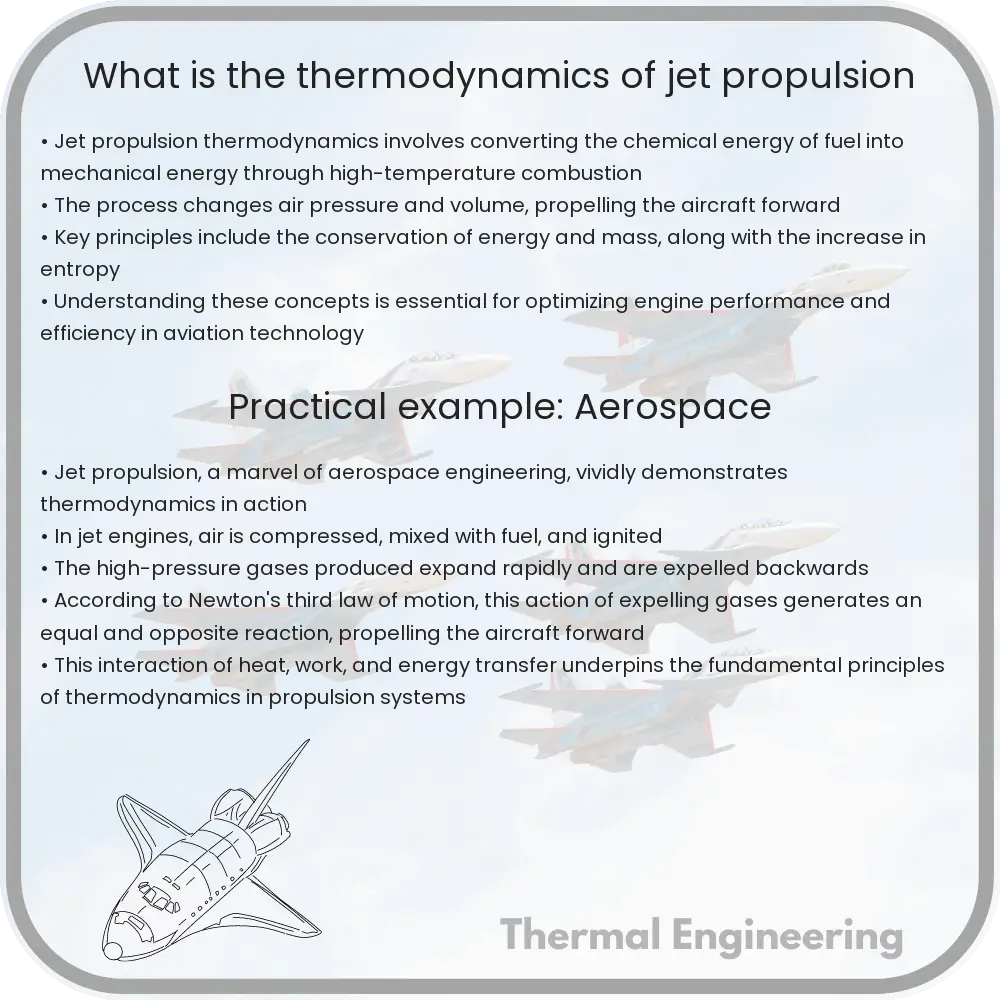Delve into the thermodynamics of jet propulsion, exploring the Brayton cycle, energy transformations, and efficiency in jet engines.

The Thermodynamics of Jet Propulsion
Understanding the thermodynamics of jet propulsion begins with the fundamental principles of thermodynamics and the mechanics of fluid motion. Jet engines, widely used in aircraft for generating thrust, leverage these principles to convert fuel into mechanical energy in the form of high-speed jet exhaust.
Basic Principles of Jet Engine Operation
Jet propulsion typically involves several key stages: intake of air, compression, combustion, expansion, and exhaust. Each stage plays a critical role in transforming chemical energy from the fuel into kinetic energy that propels the vehicle forward.
- Intake: Air is drawn into the engine.
- Compression: Compressors raise the pressure of the air.
- Combustion: Fuel is injected and ignited in the high-pressure air, releasing a large amount of heat.
- Expansion: High-temperature, high-pressure gases expand and escape through the turbine and nozzle, producing thrust.
- Exhaust: Exhaust gases are expelled, contributing to the thrust generated by the engine.
Thermodynamic Cycle: The Brayton Cycle
The operation of a jet engine is typically described by the Brayton cycle, which is a thermodynamic cycle consisting of isobaric (constant pressure) and isentropic (constant entropy) processes:
- Isentropic compression: Incoming air is compressed isentropically in the compressor, increasing its pressure and temperature.
- Isobaric combustion: Fuel combustion occurs at constant pressure, significantly raising the temperature and volume of the air.
- Isentropic expansion: The high-pressure, high-temperature gas expands isentropically through the turbine, where some of its energy is extracted to power the compressor.
- Isobaric exhaust: Finally, gases are expelled isobarically through the exhaust nozzle, producing thrust as they leave the engine.
Energy Transformations and Efficiency
The efficiency of a jet engine (thermal efficiency) can be quantified by how well it converts the energy from the fuel into useful work (thrust). The key factors influencing engine efficiency include:
- Compressor and Turbine Efficiency: How effectively these components can compress and expand the air without significant energy losses.
- Combustion Efficiency: How completely the fuel burns in the combustion chamber.
- Exhaust Losses: Energy lost through exhaust gases that are not converted into thrust.
Thermal efficiency is significantly affected by the temperature and pressure ratios achieved in the compression and combustion stages. Higher temperatures typically allow greater efficiency but are limited by material constraints due to potential damage from excessive heat.
Conclusion
The thermodynamics of jet propulsion is complex, involving careful management of air and fuel under extreme conditions of temperature and pressure. The Brayton cycle provides a framework for understanding how jet engines capitalize on thermodynamic principles to produce thrust. Engineers consistently work towards enhancing the efficiency of these processes through advances in material science and technology, aiming for engines that are not only more powerful but also more environmentally friendly.
In summary, jet propulsion beautifully illustrates how principles of physics and engineering coalesce to achieve remarkable feats, such as high-speed air travel, propelling not just planes but also human ingenuity forward.